Power and Privilege
some of the thinking behind the 'can i wear this?' series...
“Love has no gender - compassion has no religion - character has no race.”
Abhijit Naskar
This body of work began as an act of support for friends who have non-traditional relationships and association with clothing and ended up becoming an exploration of societal preconceptions of masculinity. My friends, while not gender fluid, have unique ways of using clothes as extensions of their personality. I found it unsettling to watch how the wider community treated them. They weren’t hurting anyone. If anything, their actions made them more whole. So, I set out to create a set of images that reflected possible variations of male gender expression.
While researching, I found a deeper connection. I noticed I resisted buying an orange scarf. Even though I liked it, it struck me as ‘too bright’. If as an artist doing a series on gender expression was not going to buy a scarf out of concern for societies reception to its hue, then there was more at play that needed exploring...

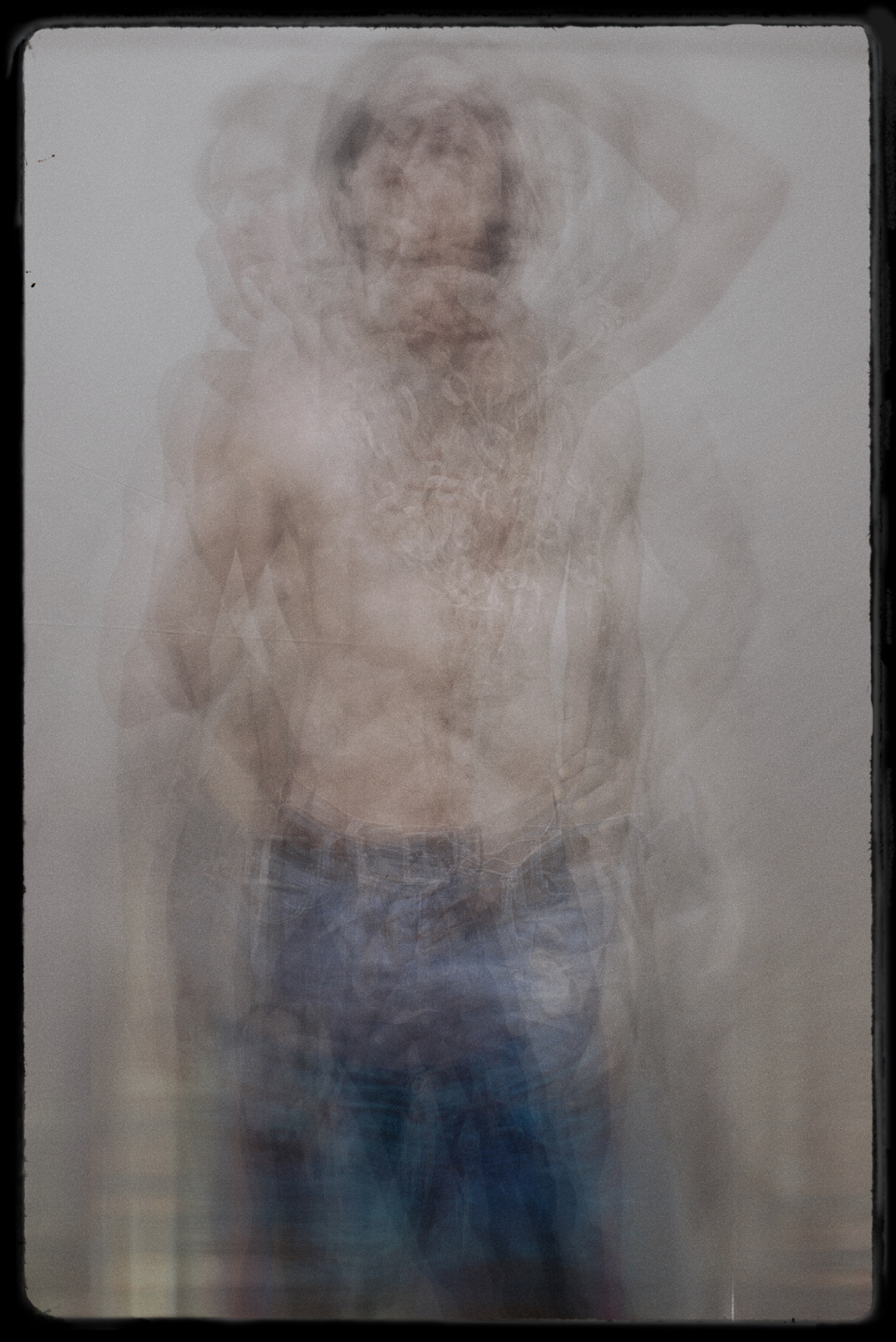
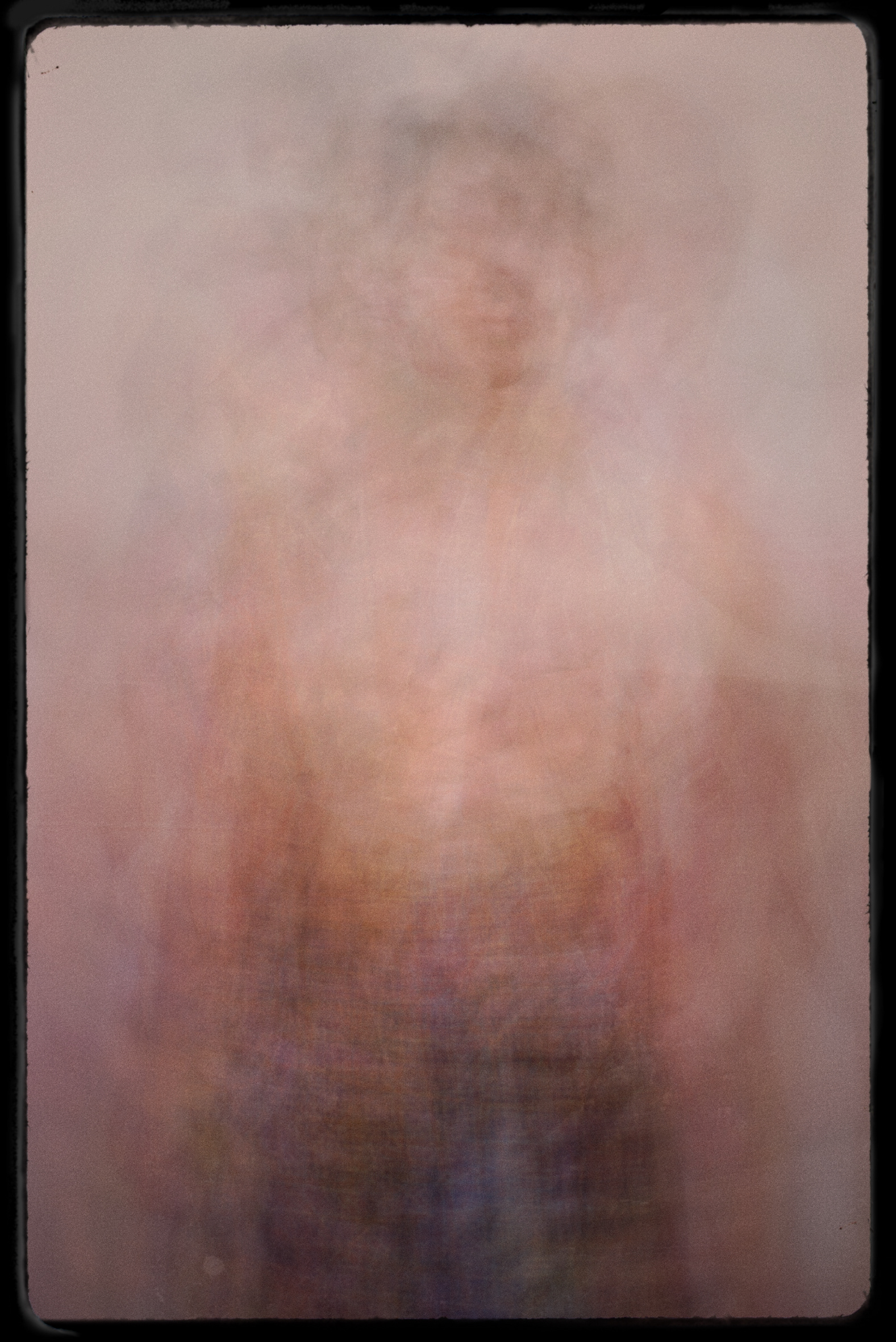


Examples of some of the initial edits
What emerged was a history of social control with clothes being the tool of implementation. In Roman times clothing tended toward neutral utilitarian designs and were based on the practical notion that children play and get dirty. By Medieval times dress is used as means of class segregation with colours and fabrics being used to define rank and station.
Later the 'Great Male Renunciation' ended these impractical displays and would see men abandon the wearing of jewellery, bright colours and ostentatious fabrics in favour of a dark, homogeneous and sombre look. Men's clothing no longer overtly operated as a signifier of social class. While these boundaries were being blurred, the differences between the sexes became more pronounced.
The historical influences surrounding gender expression, map a direct link between the embedded encoding derived from the narrative of those in power and the toxic culture of masculinity that exists today.
To counter this effect, I wanted to pose a question rather than propose a solution. The literature argues that this would only serve to further isolate those influenced by toxic behaviours. Instead, I posed a question around permission. The permission you ask of yourself and others concerning how and if it suits, and the permission you ask of society to accept you in wearing it. In posing an open unanswered question, I wanted to chip away at the metal constructs men allow to be placed on themselves regarding presentation and self-expression. Hence 'Can I Wear This?', was borne.
I didn't want any one individual to be identifiable to prevent an impression being formed. To this end, I employed the layering methods of Idris Khan. In styling the images, the artistic influences were drawn from painters Alessandro Tomassetti and William Bruce Ellis Rankin due to the softness with which they represent the male form in paintings like 'Young Man Sketching' (Rankin) and 'The Big Time' (Tomassetti). To describe the question visually, I used young aspiring fathers wearing a single item of clothing in however they wanted. It just had to be one item only.
Initially I had planned to layer the images of each of the young men in all the different cloths they interacted with (like the image on the right). But these images felt more about the individual that than society as a whole. Instead I layered up fewer images of the young men wearing just the same item of clothing. This bought the focus back to the clothes and as the men were free to choose which items to wear it brought a randomness into the final images.

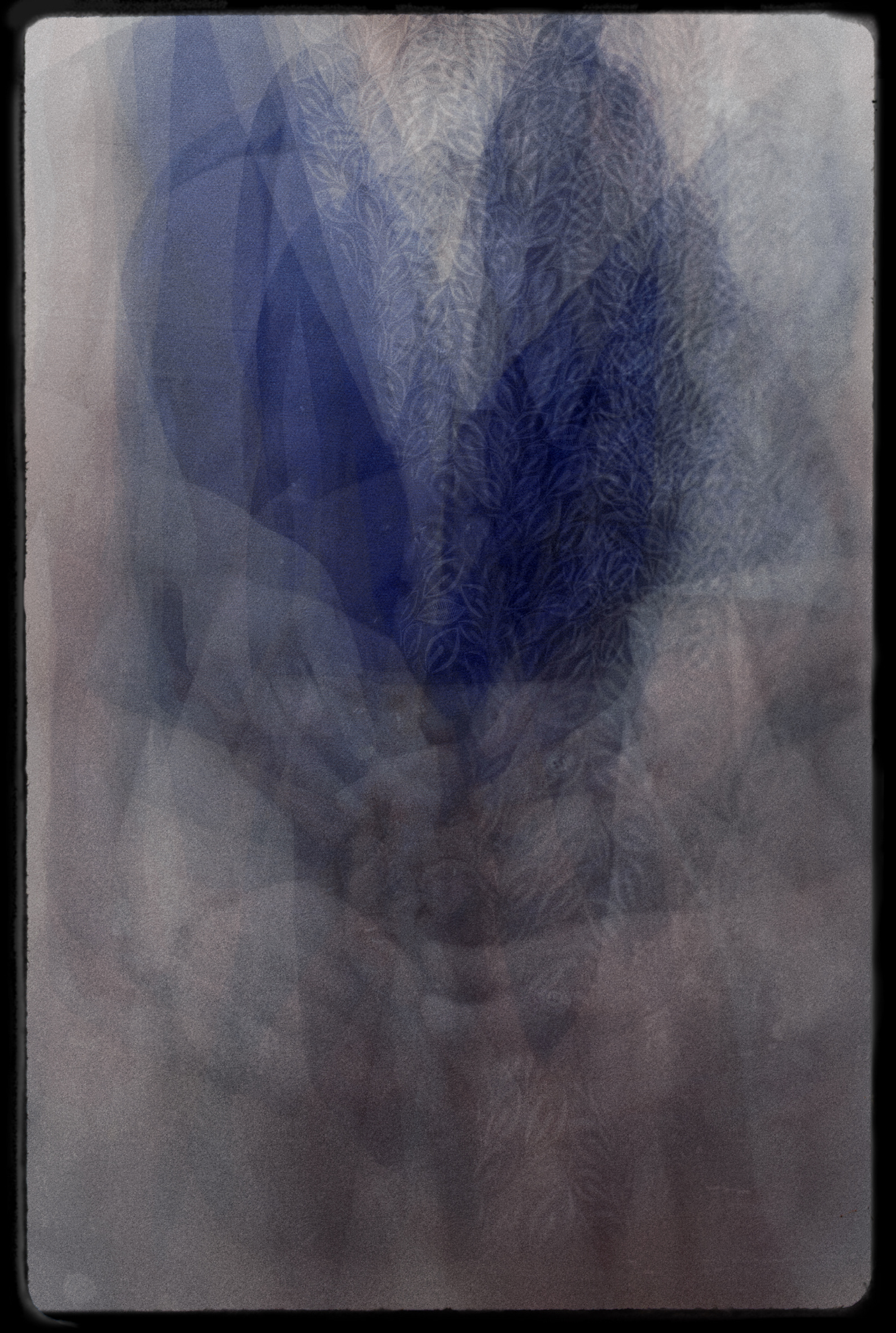

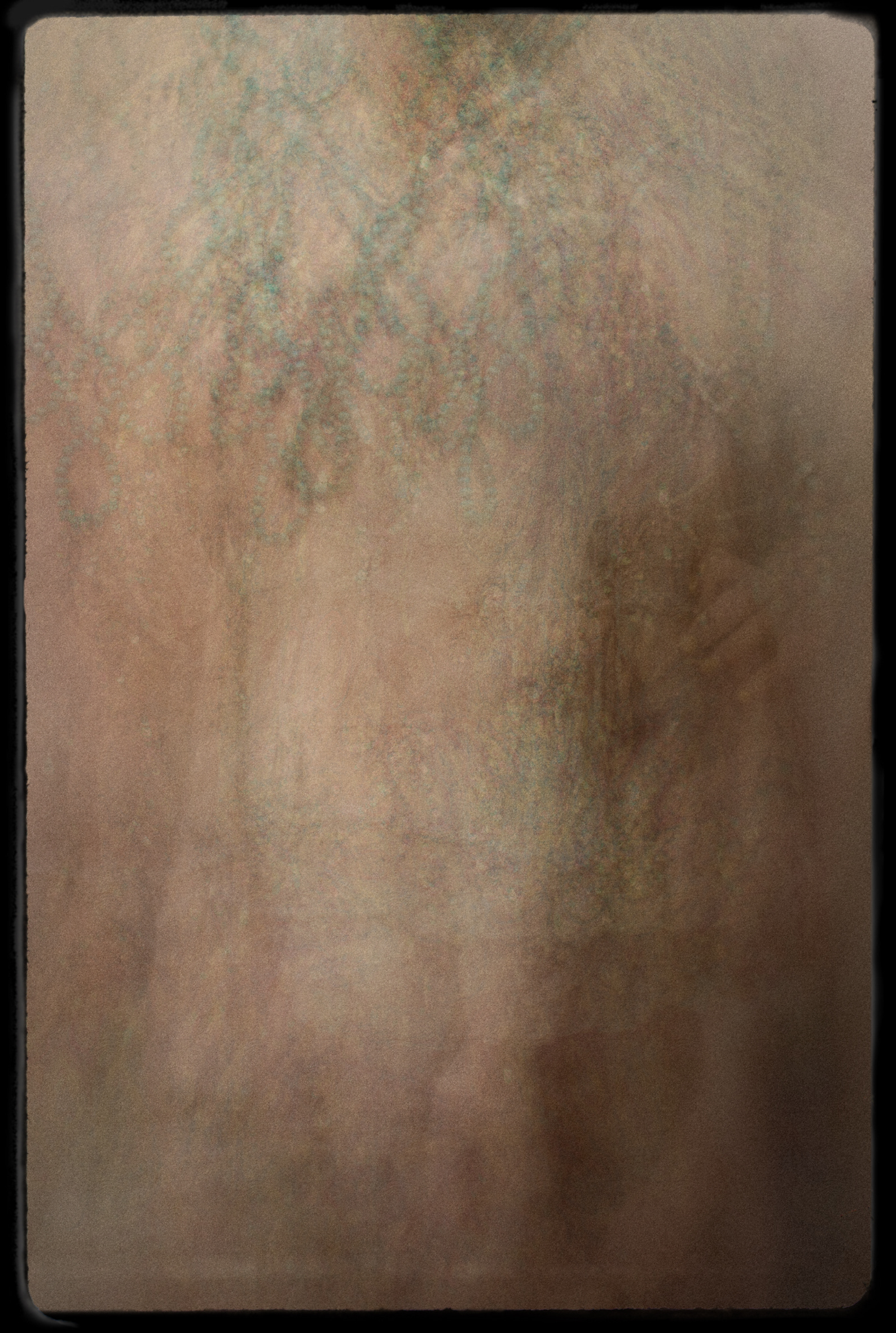
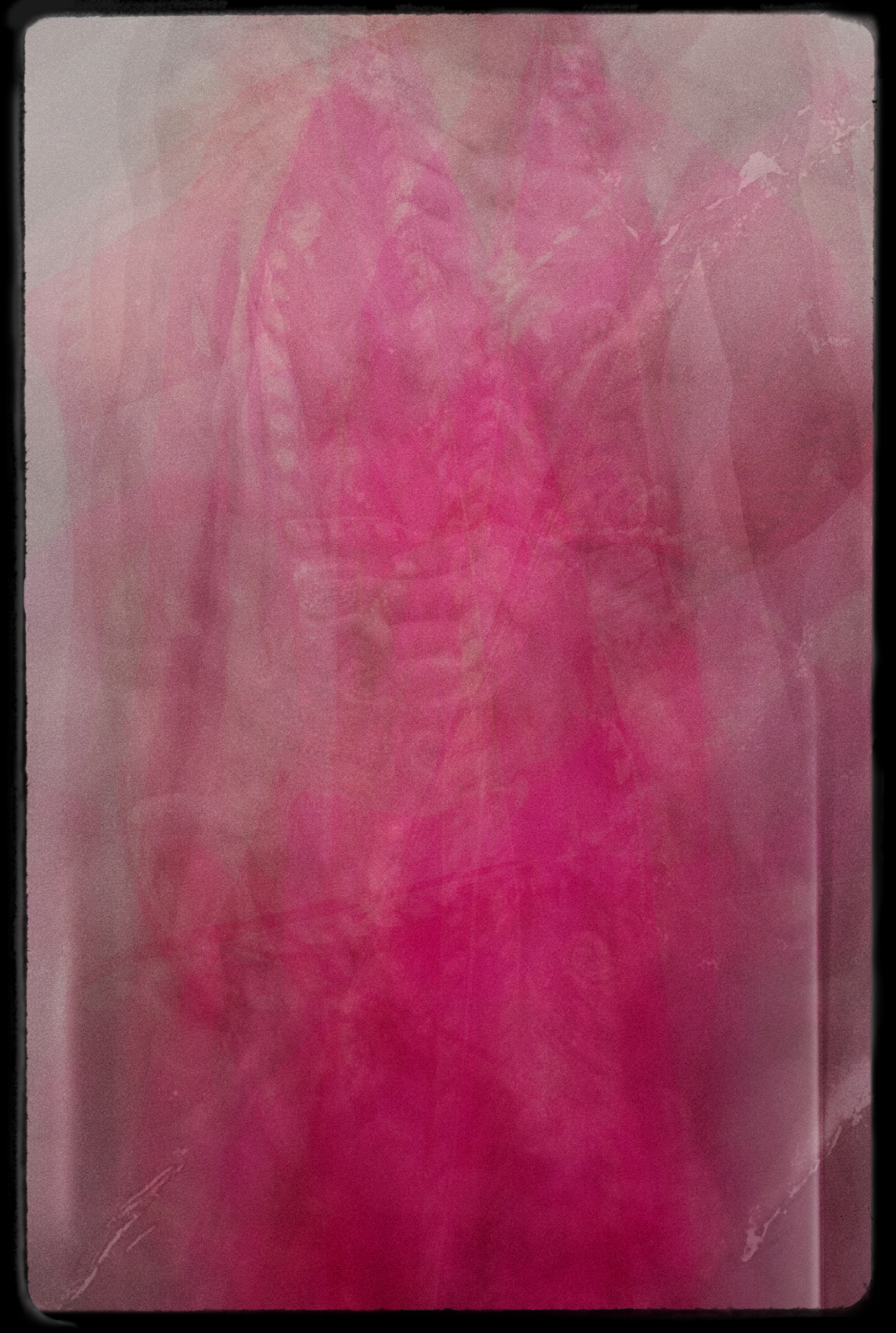
Examples of the cropped works
What emerged was a subtle dance that captured men being simultaneously vulnerable and playful. It appears as a dialogue between their hands and the clothes through the depiction the every day act of pulling on cloths and how they interacted with the fabric. For me it made the images much more intimate and relatable and I almost missed it.
I only came to notice it due to a printing error and was a lesson in not constraining my thinking, especially when I reflect on the works of Rankin and Tomassetti where the hands form a significant part of the visual impact.
The other noticing was that the fabric, regardless of the end result was basically just a weave of thread. This led to the images being cropped more tightly that I had previously planned, and to the inclusion of monochrome images into the folio. This was to bring back some of the masculinity lost in the cropping and the highlight the weave of the fabric. The use of aspiring fathers was critical. They are still impressionable, influenced by peer pressure but also our best hope of changing the attitudes of future generations.
I mapped the finished layered images into a form reminiscent of times past, in recognition of the Men's Dress Reform Party of the 1920s who tried to challenge societal perceptions toward men's clothing and as an expression of hope. A hope that only day generations hence will look back and wonder what all the fuss was about as naturally being expressively divergent is not about masculinity, it's about self-expression and character.
References & Reading
Barry, Ben & Martin, Dylan (2015) ‘Dapper dudes: Young men’s fashion consumption and expressions of masculinity’, Critical Studies in Men’s Fashion, Volume 2 Number 1
Bourke, Joanna (1996) ‘The Great Male Renunciation: The Men's Dress Reform Party in Interwar Britain’, Journal of Design History, 9.1, 1996, 23-33.
Crosson Gilpin, Caroline and Proulx, Natalie (2018) ‘Boys to Men: Teaching and Learning About Masculinity in an Age of Change’ online at https://www.nytimes.com/2018/04/12/learning/lesson-plans/boys-to-men-teaching-and-learning-about-masculinity-in-an-age-of-change.html
Edmondson, J (2008) ‘Public Dress and Social Control in Late Republican and Early Imperial Rome’ Chapter 1 in Roman Dress and the Fabrics of Roman Culture, eds. Edmondson, J. & Keith, A., Toronto and Buffalo: University of Toronto Press
Gray, Peter Ph.D. (2014) ‘But there are many benefits to letting your kid play, letting your kid be’, online at https://tocaboca.com/magazine/backing-off-is-hard-to-do/
Fairhurst, Gail T. & Connaughton, Stacey L. (2014) ‘Leadership: A communicative perspective’, Leadership, Vol. 10(1) 7–35
Hanson, Paige L. (2010) ‘Renaissance Clothing and Sumptuary Law: The Renaissance Outfit’, University of Michigan-Dearborn online at http://www-personal.umd.umich.edu/~cfinlay/sumptuary.html
Kremer, William (2013) ‘Why Did Men Stop Wearing High Heels?’, online at https://www.bbc.co.uk/news/magazine-21151350
MacDiarmid, Mark (2018) ‘Male privilege has lasting effects on boys. I see it in court every day’ online at http://www.abc.net.au/news/2018-02-08/harvey-weinstein-catherine-deneuve-independent-childrens-lawyer/9397146
Meyer, Elizebeth J. Ph.D (2014) ‘The Danger of Boys Will Be Boys’ online at https://www.psychologytoday.com/au/blog/gender-and-schooling/201403/the-danger-boys-will-be-boys
Michalko, Rod (1998) The Mystery of the Eye and the Shadow of Blindness, University of Toronto Press
Naskar, Abhijit (2017) Either Civilized or Phobic: A Treatise on Homosexuality (Humanism Series) Paperback, Amazon Publishing Company
Peterson, Jordan (2018) ’Psychologist Jordan Peterson says lobsters help to explain why human hierarchies exist – do they?’ online at The Conversation https://theconversation.com/psychologist-jordan-peterson-says-lobsters-help-to-explain-why-human-hierarchies-exist-do-they-90489
Siefkes, Martin (2012) ‘The semantics of artefacts: How we give meaning to the things we produce and use’, IMAGE, Ausgabe 16, Themenheft Bildtheoretische Ansätze in der Semiotik online at http://www.gib.uni-tuebingen.de/own/journal/upload/d964eaab22a1dc852fdaf93c6c91e2dc.pdf
Williams, Matt (2015) ‘Five Ways Boys Become Men’ for the Good Men Project online at https://goodmenproject.com/featured-content/five-ways-boys-become-men-m2w/